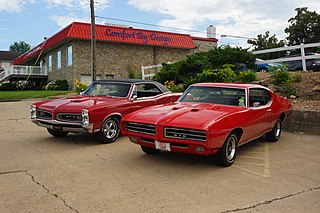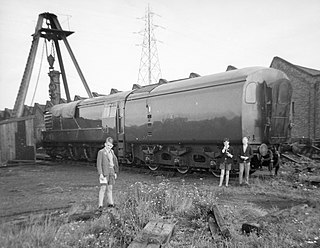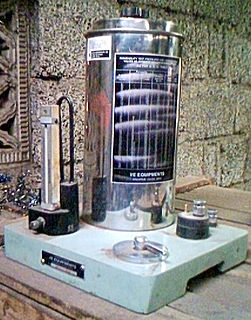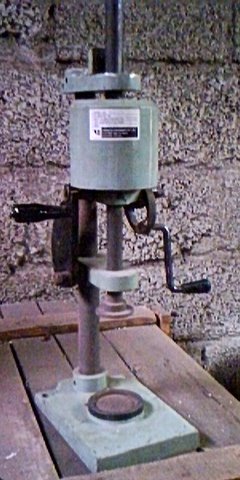
In modern archery, a compound bow is a bow that uses a levering system, usually of cables and pulleys, to bend the limbs.

The Pontiac GTO is an automobile that was manufactured by American automobile manufacturer Pontiac from 1964 to 1974 model years, and by GM's subsidiary Holden in Australia from 2004 to 2006 model years.

A shaper is a type of machine tool that uses linear relative motion between the workpiece and a single-point cutting tool to machine a linear toolpath. Its cut is analogous to that of a lathe, except that it is (archetypally) linear instead of helical.

Sand casting, also known as sand molded casting, is a metal casting process characterized by using sand as the mold material. The term "sand casting" can also refer to an object produced via the sand casting process. Sand castings are produced in specialized factories called foundries. Over 60% of all metal castings are produced via sand casting process.

GT3, meaning Gas Turbine number 3, was a prototype mainline gas turbine locomotive built in 1961 by English Electric at their Vulcan Foundry in Newton-le-Willows to investigate the use of its gas turbines in rail traction applications. It was designed by English Electric engineer J. O. P. Hughes in a project that started in the early 1950s. Externally it resembled a steam tender locomotive, although, in the case of GT3, the tender carried kerosene fuel. The designer stated the use of a traditional chassis arrangement and mechanical transmission was to avoid complicating the prototype with relatively untried technologies with regard to bogie assemblies and electrical transmission.
This article explains terms used for the British Armed Forces' ordnance and also ammunition. The terms may have slightly different meanings in the military of other countries.

A tow hitch is a device attached to the chassis of a vehicle for towing, or a towbar to an aircraft nose gear. It can take the form of a tow ball to allow swiveling and articulation of a trailer, or a tow pin, or a tow hook with a trailer loop, often used for large or agricultural vehicles where slack in the pivot pin allows similar movements. Another category is the towing pintle used on military vehicles worldwide.
The following items are commonly used automotive acronyms and abbreviations:

The Taurus PT92 is a double action/single action, 9mm, double-stack magazine-fed, short recoil-operated, semi-automatic pistol manufactured by Taurus in the former Beretta factory in São Paulo, Brazil.

Space Power Facility (SPF) is a NASA facility used to test spaceflight hardware under simulated launch and spaceflight conditions. The SPF is part of NASA's Plum Brook Station, which in turn is part of the Glenn Research Center. The Plum Brook Station and the SPF are located near Sandusky, Ohio.

A deep foundation is a type of foundation that transfers building loads to the earth farther down from the surface than a shallow foundation does to a subsurface layer or a range of depths.
The Proctor compaction test is a laboratory method of experimentally determining the optimal moisture content at which a given soil type will become most dense and achieve its maximum dry density. The test is named in honor of Ralph R. Proctor, who in 1933 showed that the dry density of a soil for a given compactive effort depends on the amount of water the soil contains during soil compaction. His original test is most commonly referred to as the standard Proctor compaction test; his test was later updated to create the modified Proctor compaction test.

The Kawasaki Ninja ZX-9R was a motorcycle in the Ninja sport bike series from the Japanese manufacturer Kawasaki produced from 1994 until 2003. There were five model incarnations across two basic designs.

Permeability is a property of foundry sand with respect to how well the sand can vent, i.e. how well gases pass through the sand. And in other words, permeability is the property by which we can know the ability of material to transmit fluid/gases. The permeability is commonly tested to see if it is correct for the casting conditions.
A casting defect is an undesired irregularity in a metal casting process. Some defects can be tolerated while others can be repaired, otherwise they must be eliminated. They are broken down into five main categories: gas porosity, shrinkage defects, mold material defects, pouring metal defects, and metallurgical defects.

Tableting is a method of pressing medicine or candy into tablets. Confectionery manufacture shares many similarities with pharmaceutical production.
In metallurgy a veining is the occurrence of a sheet like casting defect, produced by molten metal penetration into a sand casting mould.












